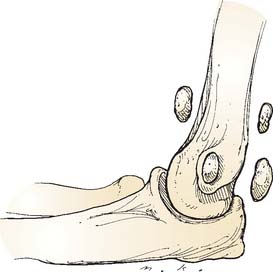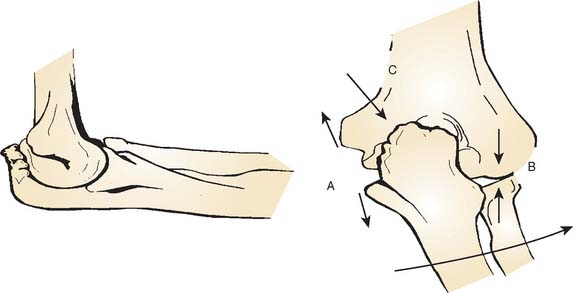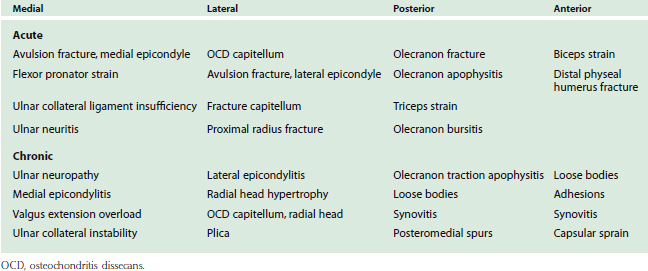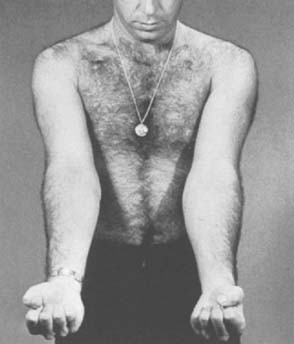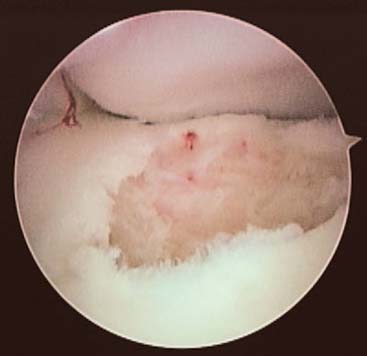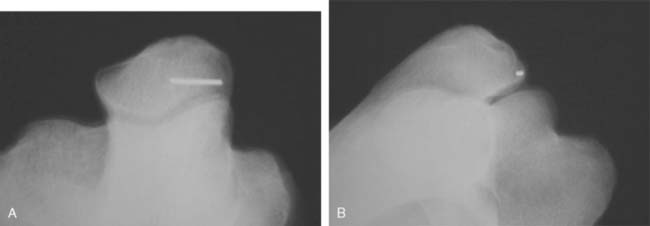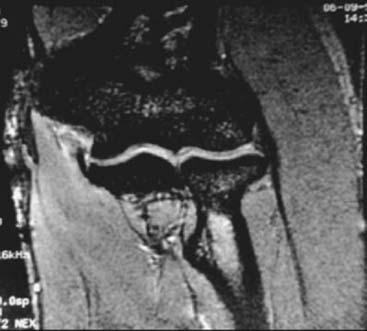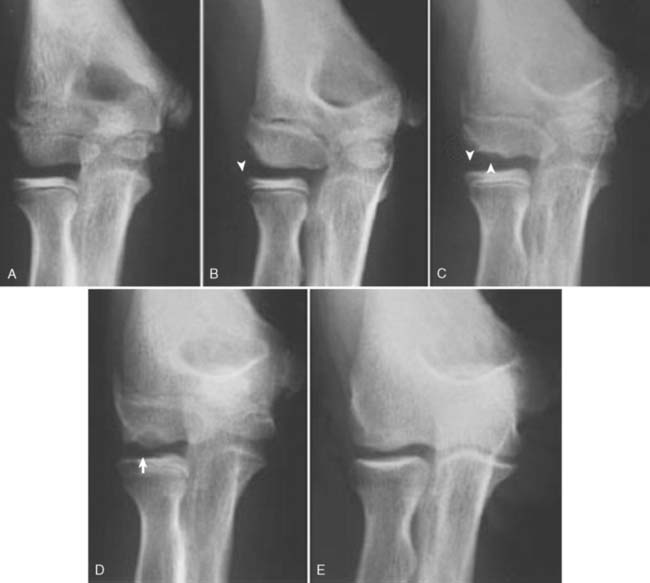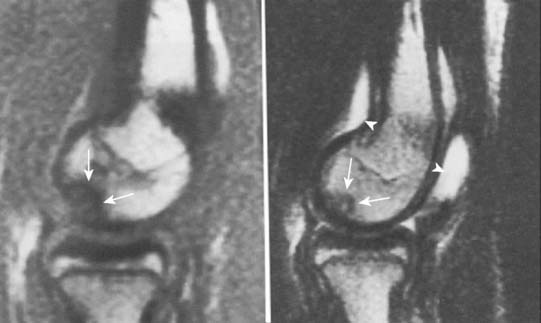CHAPTER 49 Articular Injuries in the Athlete
INTRODUCTION
Activities such as throwing, lifting, and gymnastics cause large stresses across the elbow joint, which can result in a multitude of pathologies.16,21,90 In skeletally immature athletes, these stresses, combined with the developing bony anatomy and unique physeal biomechanics, lead to distinct injury patterns. In the past, macrotrauma, such as fractures and dislocations, were common in this age group; but recently, there has been a paradigm shift. As more children have begun participating in organized athletics at younger ages, and, as sport specialization with a year-round focus has become more common, repetitive microtrauma is causing a prevalence of overuse injuries. These include syndromes affecting the ligaments, capsule, muscles, and articular surfaces of the joint.2,17 Additionally, osseous manifestations may occur, such as stress fractures, osteophytes, loose bodies, osteochondral lesions and epiphyseal or apophyseal hypertrophy, and avulsion, or fragmentation.44 To better understand the injuries suffered in youth athletes, a thorough understanding of the bone and cartilage anatomy and knowledge of the forces associated with different overhead activities is required.
Adult throwers may present with loose bodies and stress fractures as well. However, more commonly, patients in this age group present with symptoms consistent with chronic valgus insufficiency, such as valgus extension overload, lateral compression injuries, and medial tension injuries.4,64,117,118 Acute fractures and dislocations may occur in athletes of any age with a frequency comparable to that of the general population, but these injuries are less common than ligamentous instability.32,35
ANATOMY
BONE AND CARTILAGE
Elbow anatomy, including the ossification centers and pattern of ossification in the elbow, is discussed in detail in Chapters 1 and 2. Elbow injury patterns in skeletally immature athletes are associated with stages of growth and development; the skeletal developmental stage defines the weakest link. Childhood terminates with the appearance of all secondary centers of ossification, adolescence terminates with the fusion of all secondary ossification centers, and young adulthood is signified by the completion of skeletal growth.90 Injuries during childhood are related to the developing epiphyses. Excessive forces may alter vascularization or ossification. During adolescence, peripheral fragment avulsions, subchondral osteonecrosis, or physeal injury or nonunion may occur. By the time patients reach young adulthood, stress reactions become more typical, as do ligamentous or capsular injuries.90
Accessory ossicles are of particular anatomic concern to physicians treating articular injuries. These may occur extra-articularly (medial epicondyle or tip of the olecranon in the triceps tendon) or intra-articularly (olecranon fossa, coronoid fossa, lateral epicondyle)45 (Figs. 49-1 and 49-2). Persistent apophyses at the medial or lateral epicondyle may be confused with loose bodies. Sesamoid fabella cubiti in the biceps tendon, patella cubiti in the triceps tendon, or accessory ossicles such as the supratrochlear posterius in the olecranon fossa or the os supratrochlear anterius in the coronoid fossa must also be distinguished from pathologic loose bodies.120
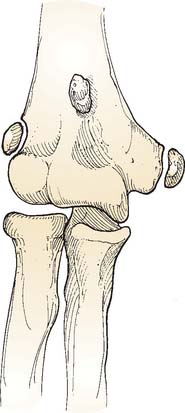
FIGURE 49-1 Accessory ossicles, medial and lateral epicondyle apiphysis about the elbow joint (anteroposterior view).
(Redrawn from Bennett, J. B., and Mehlhoff, T. L.: Articular injuries in the athlete. In Morrey, B. F. [ed]: The Elbow and Its Disorders, 3rd ed. Philadelphia, Saunders, 2000, p. 563.)
LIGAMENTS
Ligamentous anatomy in the elbow region is discussed at length in Chapters 2, 47, and 48. A brief review of their functional anatomy as it relates to articular injuries is presented here.
The ulnar collateral ligament (UCL) complex consists of three main portions: the anterior band, the posterior band, and the transverse ligament. The anterior band serves as the primary stabilizer to valgus stress, with the radiocapitellar joint providing secondary stability.27,80,97 Repetitive valgus stresses associated with activities such as throwing generate three, well-described forces on the elbow and its articular surfaces: (1) medial tension, (2) lateral compression, and (3) posterior shear (Fig. 49-3).30,107 Microtrauma to the anterior band of the UCL may cause progressive valgus laxity, which causes an alteration of the basic biomechanics of the joint. Shear forces on the olecranon develop, leading to synovitis, osteophytes, and loose bodies in the posterior compartment. Additionally, an increase in compressive forces is transmitted to the radiocapitellar joint. Fragmentation, loose bodies, or both may result. These changes in the elbow articulation may result in well-described clinical findings, such as increased valgus carrying angle, flexion contractures, medial epicondyle hypertrophy or fragmentation, and trochlear or olecranon fragmentation.42,54,90
DIAGNOSIS
HISTORY
A detailed history helps narrow the extensive differential diagnosis of elbow pain in athletes (Table 49-1). We find it most helpful to classify injuries by mechanism, with further subclassification based on anatomic compartment involved (medial, lateral, posterior) and onset of pain (acute, chronic). Pertinent information includes age, sport played, level of competition, position, characterization of pain (location, duration, onset), mechanism of injury, and past medical history. As mentioned earlier, skeletal age can provide the physician with useful information regarding the likely diagnosis.
Different sports predispose athletes to different injuries. Gymnasts must lock out their elbows to support their body weight, causing posterior elbow injuries.93 Baseball players, especially pitchers, put large magnitude valgus stresses on the elbow, which can result in myriad injuries. For pitchers in particular, effectiveness over their previous outings, numbers of pitches thrown, types of pitches thrown, phase of throwing associated with the pain, and parent’s or coach’s observations of any changes in mechanics are pertinent. A detailed knowledge of the phases of throwing will help the treating physician narrow the differential diagnosis of elbow pain in throwers. This is discussed at length in Chapter 47. It is important to note that number of pitches thrown and not innings pitched is what places throwers at risk for injury.93
PHYSICAL EXAMINATION
Bilateral upper extremities should be examined, beginning with inspection to note muscle atrophy or hypertrophy, bony deformities, elbow asymmetry, or flexion contractures.20 Range of motion of both shoulders and elbows is tested, and carrying angles of the elbows should be compared (Fig. 49-4). Palpation should include the medial and lateral epicondyles, the medial and lateral collateral ligaments, the sublime tubercle, the radial head, and the olecranon process. Careful examination of the ulnar nerve may reveal subluxation, tenderness, or both. Lateral ligaments are tested with varus stress and internal rotation of the arm, whereas medial ligament stability is tested with a valgus stress applied to an externally rotated arm. Special maneuvers used to help diagnose elbow medial collateral ligament (MCL) insuffiency include the moving valgus stress test and the milking test, both of which are detailed in Chapters 4 and 46. Pain with forced hyperextension may suggest hyperextension valgus overload syndrome, whereas mechanical locking or catching may indicate loose bodies or osteochondral defects. In throwing athletes, it may help to have them simulate a pitch to reproduce their symptoms. The examination requires a complete neurologic and vascular assessment, with special attention given to the ulnar nerve.
IMAGING
Standard anteroposterior (AP), lateral, and reverse axial views of both the affected and contralateral elbow are an essential part of the workup. Stress views may help detect subtle ligamentous instability; however, negative stress films do not rule out ligamentous pathology. Magnetic resonance imaging (MRI) can be used in these cases to further evaluate the ligament in question. Additionally, MRI is helpful for diagnosing osteochondritis dissecans (OCD) lesions, stress fractures, and other soft tissue pathology. Computed tomographic (CT) scans are also useful to evaluate loose bodies, bone spurs, and articular cartilage lesions.
ARTHROSCOPY
Arthroscopy of the elbow can facilitate or confirm diagnosis of both articular and ligamentous injuries (Fig. 49-5). For example, OCD lesions can be inspected and probed at arthroscopy, which can help dictate the appopriate treatment; the arthroscopic valgus stress test can be used to confirm disruption to the medial UCL.8,12 Chapters 38, 39, and 41 detail the expanding role of arthroscopy of the elbow in the treatment cartilage and synovial lesions in the athlete, such as lateral synovial plicas, loose bodies, OCD lesions, and posterior compartment osteophytes.24,31,51
MEDIAL TENSION INJURIES IN ADOLESCENCE
MEDIAL EPICONDYLAR STRESS LESIONS (LITTLE LEAGUER’S ELBOW)
The term Little League elbow was originally used by Bennett to describe the spectrum of bony changes caused by medial tensile forces and lateral compressive stresses in young, developing throwers.17 In these athletes, the repetitive tensile stress on the medial epicondyle caused by valgus stress and the pull of the flexor-pronator muscle mass and the medial UCL leads to microtrauma at the epiphysis.2,3,36,37,88–90 The resulting spectrum of injury at the medial epicondyle includes subtle widening, separation, fragmentation, and hypertrophy (Fig. 49-6). A recent study revealed that up to 63% of little leaguers had soreness at the medial epicondyle, and of these throwers, 70% exhibited separation and 40% had evidence of fragmentation.48

FIGURE 49-6 Radiograph of medial epicondylar stress lesion demonstrating fragmentation and separation.
Clinically, patients may present with progressively worsening, medial-sided elbow pain that is exacerbated with throwing. A triad of symptoms has been described, which includes pain in the late cocking and early acceleration phases, loss of velocity and distance, and decreased throwing effectiveness. On examination, there is point tenderness at the medial epicondyle and a flexion contracture. Patients have pain with valgus stress, but no frank instability. Radiographic findings range from subtle widening to separation or fragmentation. Medial epicondylar stress lesions are benign entities that respond well to cessation from throwing and, if flexion contractures are present, physical therapy for stretching. A return to throwing is predicated on complete resolution of symptoms and the absence of tenderness on examination. A gradual return using a strict throwing program emphasizing proper mechanics is critical.
It is important to recognize that, at times, the term Little Leaguer’s elbow is used as a “wastebasket diagnosis” to refer to a constellation of injuries including medial epicondylar avulsion fractures, medial epicondyle apophysitis, OCD, Panner’s disease, hypertrophy of the ulna, olecranon apophyseal injury, and medial UCL injury.3,41,45,71,99,102 In this context, the term is nonspecific and not helpful for tailoring treatment. When evaluating young throwers with medial elbow pain, it is important to make a specific diagnosis.
MEDIAL EPICONDYLE AVULSION FRACTURES
When a significant, acute, valgus stress is applied through a violent muscle contracture such as during the throwing motion or arm wrestling, an avulsion fracture of the medial epicondyle can result.72,84 Separation classically occurs through the epiphyseal growth plate, because this is the weakest area of the epicondyle. Clinically, this results in tenderness over the epicondyle and, often, a flexion contracture that may be greater than 15 degrees. Assessment of ulnar nerve function is critical, and physicians must maintain a high index of suspicion for a spontaneously reduced elbow dislocation. Radiographs confirm the diagnosis. A view that we have found particularly useful to evaluate the medial epicondylar apophysis in children is the posterior impingement view as described by John Conway (John Conway Personal communication, 2002)34 (Fig. 49-7A and B). It is an axial view with the elbow maximally flexed and the humerus externally rotated 40 degrees. The x-ray beam is directed perpendicular to the humeral axis. Additionally, this view is useful to visualize the posterior medial olecranon margin in cases of valgus extension overload.
Woods and colleagues123 have classified the lesions based on patient age and fragment size. Type I injuries occur in younger patients. These are large fragments typically involving the entire apophpysis with the MCL, and the fragments often displace and rotate. Type II fractures occur in adolescents. These fragments are usually smaller, representing an avulsion of the flexor origin. The anterior oblique ligament is usually intact.
Treatment depends on the amount of fragment displacement, although the definition of acceptable displacement is controversial. Less than 3 to 5 mm of displacement is typically well tolerated and responds well to splinting for 2 to 3 weeks, followed by conversion to a hinged elbow orthosis.59 Operative indications include displacement greater than 3 to 5 mm, fragment rotation, valgus instability, ulnar nerve dysfunction, and fragment incarceration (Fig. 49-8). An increasing number of authors are advocating more aggressive treatment of these injuries in competitive, skeletally immature overhead athletes using more then 2 mm of displacement as an indication to operate.53 This is based on studies showing that subtle instability after non-operative management causes degenerative radiocapitellar changes.53
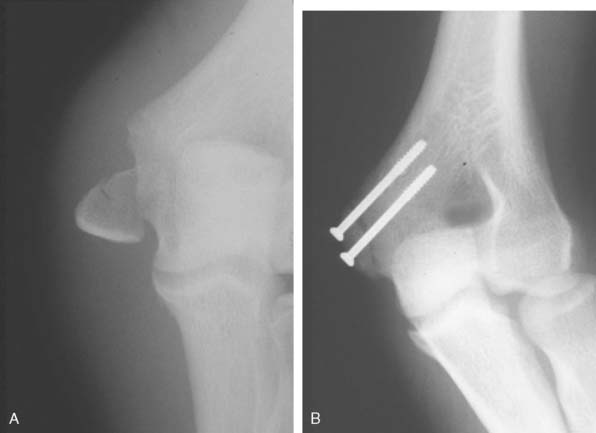
FIGURE 49-8 A, Medial epicondyle fracture. B, Medial epicondyle fracture treated with internal fixation.
Gravity Stress Test
Schwab and associates105 described a radiograph using gravity to impart a valgus stress to help diagnose instability. With the patient lying supine, the shoulder is brought into maximum external rotation (Fig. 49-9). At this point, the sagittal plane of the elbow is parallel to the floor, and the weight of the forearm is resisted solely by the flexor forearm mass and anterior oblique ligament. Instability of the elbow, secondary to loss of MCL continuity, is indicated by movement of the fragment distally. A positive gravity stress test is an indication for surgical treatment.
MEDIAL LIGAMENT INSTABILITY
Injuries of the medial UCL are relatively uncommon in younger throwing athletes; however, there has been an alarming trend of increasing numbers of high school–aged athletes being treated for UCL insufficiency.93 The increasing incidence of these throwers requiring UCL reconstruction may be directly related to overuse of the throwing arm and throwing breaking balls at youngerages.93 Clinically, these patients usually have subtle findings of instability on examination. The previously described gravity stress test is sometimes useful in diagnosing UCL injury, although MRI is usually a better imaging modality (Fig. 49-10).
Treatment options include direct surgical repair or ligament reconstruction.54,57 According to Jobe, direct repair is indicated if stability can be restored; otherwise reconstruction with a tendon graft should be performed. Petty et al.93 found that the results of UCL reconstruction in high school athletes are less successful than the results in older age groups. For a more complete discussion of UCL injury diagnosis and treatment, please refer to Chapter 47.
LATERAL COMPRESSION INJURIES IN ADOLESCENCE
OSTEOCHONDRITIS DISSECANS OF THE CAPITELLUM
OCD of the capitellum is a disease of unclear etiology that typically affects patients aged 10 to 15 years.71,124 The most commonly accepted theory is that the lesion is secondary to vascular insufficiency.88,124 Several authors have noted the association between throwing and OCD.1,2,6,13 Tullos and King concluded that compressive forces between the capitellum and radial head occur during the throwing motion.118 Schenk and Dalinka104 showed that a biomechanical mismatch between the radial head and capitellum exist. Together, these studies support the theory that compressive forces produce focal arterial injury and subsequent bone death (or OCD lesions).
The focal lesions usually occur in the dominant arm and cause pain and a flexion contracture of 15 degrees or more. A joint effusion is often present. Initial radiographs may be normal. As the disease progesses, irregularities of the capitellum or even a defect in the bone can develop. Loose bodies may be present. Takahara described the use of a 45-degree flexion AP elbow radiograph to reveal lesions that may be underestimated by conventional radiographs110,112 (Fig. 49-11A and B).
Arthrograms, ultrasound, and MRI are useful imaging modalities.50,112 The sensitivity and specificity of MRI make it particularly valuable in diagnosing capitellar lesions19 (Fig. 49-12). Decreased signal on T1-weighted images and increased signal on T2-weighted and fast spin–echo sequences are consistent with marrow edema, and are often present before similar changes are seen on plain film.66,104 MR arthrograms are helpful to demonstrate unstable lesions that are not loose bodies.104 It is important to note that there is a normal anatomic sulcus between the lateral condyle and capitellum that may be mistaken for an osteochondral fragment.66 This sulcus is located posteriorly, whereas OCD lesions are usually located more anteriorly.
Stay updated, free articles. Join our Telegram channel

Full access? Get Clinical Tree


